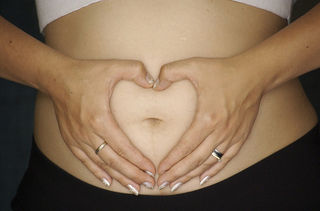Depression
The Myth of the Glowing New Mother
Postpartum depression is real, and linked to the challenges of modern life.
Posted February 11, 2016
This post was authored by Gabrielle Lewine, Ph.D. candidate at University of Southern California

Just last week, the US Preventive Services Task Force issued a recommendation to incorporate screening for post-partum depression (PPD) into standard medical care surrounding childbirth. This reflects the medical community’s increasing awareness of and concern about PPD, defined as depressive symptoms (e.g., loss of interest, feelings of feelings of worthlessness, appetite/sleep disturbance) that begin within four weeks of delivery, last at least two weeks, and significantly impact a mother’s ability to function. The recommendation comes not a moment too soon.
One in 8 child-bearing women will suffer from PPD. Given the well-established link between stressful life events and subsequent depressive episodes, this figure shouldn’t come as a surprise. Having a child is perhaps the most stressful transition in adult life – some researchers have even labeled it a “crisis” for new parents. The stressors associated with the transition to motherhood, coupled with the hormonal roller-coaster surrounding delivery, create a perfect storm for an episode of PPD. So, why has PPD, until recently, been stigmatized, poorly understood, and rarely talked about?
The answer, perhaps, lies in the mismatch between stereotypes surrounding motherhood and motherhood’s grueling, messy reality. A quick Google Image search of the phrase “new mother” should let you know what to expect: a beautiful woman, skin glowing, smiles and nuzzles her gently cooing newborn. There seems to be a Hallmark effect at work—if we can be convinced to celebrate the martyrdom of an ancient saint by giving our partners chocolates and flowers in mid-February, we may be just gullible enough to expect a montage of peaceful napping and giggling peekaboo games upon bringing a new life into the world. So, what happens when the transition to parenthood is marked by despair and guilt rather than joy and resounding Hallelujah choruses? Is the New Mother archetype as far removed from its historical context as our romantic St. Valentine?
Jennifer Hahn-Holbrook and Martie Haselton, a duo of evolutionary psychologists from Chapman University and UCLA, have suggested a provocative answer to the question of PPD in its historical context. They suggest another mismatch: between today’s society and the society in which humans adapted to motherhood – a mismatch which may explain an increased likelihood of PPD in modern mothers. Some elements of this mismatch are biological in nature. For example, our distant ancestors consumed more omega-3 fatty acids , an anti-inflammatory nutrient found in fatty fish that is underrepresented in modern grain-heavy diets. Support for the role of omega-3 fatty acid deficiency in PPD comes from an inverse relationship between the amount of seafood consumed and the rate of PPD across countries. Japan, for example, has the highest seafood consumption among the countries examined and reports a mere 2% prevalence rate of PPD compared to the 11.5% prevalence reported by the United States. Sure enough, several randomized controlled trials have found that omega-3 fatty acid supplements can be an effective treatment for depression. Additional biological mismatch factors include modern-day deficiencies in vitamin D (i.e., sunshine) and exercise.

Other kinds of mismatch come from changes in the structure of social and familial support over the centuries. For example, hunter-gatherers typically lived in groups of extended family: grandparents, aunts, uncles, and older siblings. Having family members nearby gave mothers two benefits: helping hands for childcare and an emotional support network to navigate its many ups and downs. In today’s society, mothers may live several cities, states, or countries away from their extended family, which forces them to bear more childcare burden and distances them from this valuable support.
Unfortunately, today’s new mothers, compared to their nomadic ancestors, live sedentary lives, largely indoors, isolated from family, and with insufficient omega-3 fatty acids in their diets – all factors that may increase the risk for developing PPD. As society continues to change, more stressors of modern civilization may challenge new moms. For example, women participate in the workforce in higher numbers; almost a quarter of new mothers return to work within 2 weeks of delivery. The impossible choice between taking unpaid leave and securing childcare, both of which represent financial and emotional stressors, is a relatively new predicament that may exacerbate the risk of PPD.
The discussion of life as a 21st century new mother would be incomplete without mention of social media. If you’re a regular Facebook user who counts new parents among your friends, you probably see a slew of proudly posted baby photos that look suspiciously like the “new mother” Google search mentioned above. While new mothers suffering from PPD may be experiencing numbness, guilt, and difficulty developing an attachment with their child, a barrage of such photos is likely to exacerbate feelings of shame and isolation.
So, what do omega-3 fatty acid deficiency and Facebook humble-bragging moms have in common? They define today’s society as a uniquely difficult place for a new mother, and create the circumstances in which PPD affects 1 in 8 women. Remember that number next time you speak to a friend with a newborn and perhaps, before you ask about her child, ask how she is doing. The myth of the glowing New Mother does no justice to the complexity and idiosyncrasy of each woman’s reaction to motherhood. Happy Valentine’s Day.

References
- Hahn-Holbrook, J., & Haselton, M. (2014). Is postpartum depression a disease of modern civilization? Current Directions in Psychological Science, 23(6), 395-400.
- Klerman, J. A., Daley, K., & Pozniak, A. (2012). Family and Medical Leave in 2012: Technical Report (Rep.).
- LeMasters, E. E. (1957). Parenthood as crisis. Marriage and Family Living, 19, 352-355.y
- Siu, A. L. (2016). Screening for depression in adults. Journal of the American Medical Association, 315(4), 380-387.
Recommended Reading
Kim, J. (2014, May 8). Postpartum Stigma: Why My Patient Committed Suicide. Retrieved from http://www.thedailybeast.com/articles/2014/08/05/postpartum-stigma-why-…




